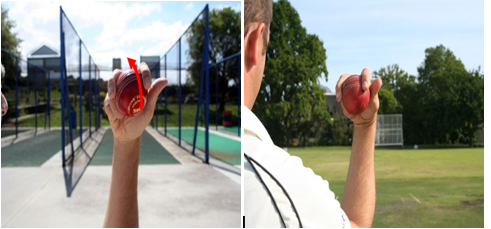Ø Grip
The seam of the ball runs
across the fingers and most of the spin imparted on the ball using the index
and middle fingers.
The ball should not be held
too tightly and the thumb should be bent back in order to ensure that it is out
of the way.
Ø Release
At the time of the release,
the back of your hand should face towards square leg and your fingers should
spin the ball similar to an off-break.
The changed wrist position
causes the ball to behave like a leg-break. This finger spin along with the
rotation from the wrist and shoulder imparts the spin to leg-break.
You can vary the pace for
the doosra just like you can with your normal off-spinner.
It’s unnatural
 The bowl like this is very
difficult. It is really tough to get your wrist into that position
without bending your arm.
The bowl like this is very
difficult. It is really tough to get your wrist into that position
without bending your arm.
Ø Surprise variation
This method is best if you
want to use the doosra as a surprise variation as the wrist action resembles
the standard off-spinner action, and therefore easier to hide from the batsman.
Therefore, it is effective
in deceiving batsmen when they expect the ball to turn the other way. This is
the method used by Saqlain Mushtaq.
Method 2: Over
the back of the hand
The
second method is the more common one, as it is slightly easier to bowl. It is
the method used by Ajmal and Murali. Watch the video to see Ajmal bowl one.
A little tip
about Ajmal’s doosra is that he he lifts his thumb way off the ball when he
bowls the doosra. He has to get it out the way to make space for the ball to go
over the wrist.
But,
even though you can probably pick it that way the batsmen still seems to
struggle!
Ø Grip
The grip for the doosra is
identical to the standard off-spinner’s grip. The seam of the ball runs across
the fingers.
The ball should not be held
too tightly and the thumb should be bent back in order to ensure that it is out
of the way.
The seam will obviously come
out scrambled this way.
Just before release, the
wrist is rotated so that the back of the hand faces1st slip.
Thought the previous method
was difficult?
If you struggled with the
previous method you might tie yourself in a knot with this one.
This is the way Murali
and Ajmall does it. And unless you have wrists made of rubber you will
struggle.
Then again, I do not know
you, and you just very well be born with wrists made for this method. So, by
all means, give it a go.
Ø Stock delivery
This method is best if you
want to use the doosra as your stock delivery as is more obvious and easier to
pick.
It is not as effective as a
surprise delivery as the action (at release of the ball) is quite different
from the standard off-spin action
Ø Release
The ball is released out of
the back of the hand over the fingers with the fingers pointing to 1st slip
just after release. The ball should be released with a whipping action and
therefore a flexible wrist is essential. The spin is created by a combination
of finger and wrist spin, as opposed to mostly finger spin/wrist angle in
Method #1.
Ø Open up a bit
For all you wannabe doosra
bowlers out there, I can suggest that you open up your action slightly for this
one.
That will help you in
flexing your wrist the right way to ensure you can get the ball angling to the
off-side.
Dropping your bowling
shoulder will also assist you in getting the necessary flexibility to get your
doosra going.





